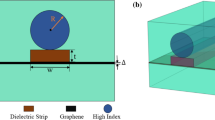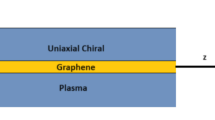Abstract
Excitation of novel graphene plasmons is examined using finite-element analysis via COMSOL RF module 5.6. The theoretical model is simulated with graphene grating on the glass substrate having fixed periodicity (Λ = 700 nm) by illumination with transverse magnetic (TM) polarized light through the substrate side. The effect of thickness variation on SPPs excitation has been acquired from transmission spectra while keeping the periodicity and slit width of grating structure constant via analyzing the trend followed by the resonance dips. The electric and magnetic field behavior has also been analyzed for each thickness, and a specific grating thickness of 10 nm was taken into consideration owing to the thickness constraints regarding graphene. Slit width variation of the grating structure has been investigated using far-field analysis to observe the formation of SPPs from transmission spectra and near-field analysis for understanding the underlying physics. These analyses resulted in SPP excitation more appreciable at slit widths in between 250 and 350 nm. The slit width range regarding the chosen periodicity supports the most efficient plasmonics mode and many applications of such devices are found in real life.







Similar content being viewed by others
References
Afsheen S et al (2019) Modeling of 1D Au plasmonic grating as efficient gas sensor. Mater Res Exp 6(12):126203
Afsheen S et al (2020) Surface plasmon based 1D-grating device for efficient sensing using noble metals. Opt Quantum Electron 52(2):64
Afsheen S et al (2020a) Optimizing the sensing efficiency of plasmonic based gas sensor. Plasmonics 2020:1–6
Afsheen S et al (2020b) Optimizing the sensing efficiency of plasmonic based gas sensor. Plasmonics. https://doi.org/10.1007/s11468-020-01318-0
Anker JN et al (2010) Biosensing with plasmonic nanosensors. Nanosci Technol 2010(308):319
Billaudeau C et al (2009) Tailoring radiative and non-radiative losses of thin nanostructured plasmonic waveguides. Opt Express 17(5):3490–3499
Darmanyan SA, Zayats AV (2003) Light tunneling via resonant surface plasmon polariton states and the enhanced transmission of periodically nanostructured metal films: an analytical study. Phys Rev B 67(3):035424
Fei Z et al (2011) Infrared nanoscopy of Dirac plasmons at the graphene–SiO2 interface. Nano Lett 11(11):4701–4705
Gao W et al (2012) Excitation of plasmonic waves in graphene by guided-mode resonances. ACS Nano 6(9):7806–7813
Hessel A, Oliner A (1993) A new theory of Wood’s anomalies on optical gratings (from Applied Optics 1965). SPIE Milestone Series MS 83:332–332
Iqbal T et al (2019) An optimal Au grating structure for light absorption in amorphous silicon thin film solar cell. Plasmonics 14(1):147–154
Iqbal T et al (2019) Investigation of plasmonic bandgap for 1D exposed and buried metallic gratings. Plasmonics 14(2):493–499
Iqbal T et al (2021) Study of plasmonic bandgap by optimization of geometrical parameters of metallic grating devices. Solid State Commun 2021:114212
Javaid M, Iqbal T (2016) Plasmonic bandgap in 1D metallic nanostructured devices. Plasmonics 11(1):167–173
Ju L et al (2011) Graphene plasmonics for tunable terahertz metamaterials. Nat Nanotechnol 6(10):630
Kociak M et al (2011) Spatially resolved EELS: the Spectrum-Imaging technique and its applications Scanning Transmission Electron Microscopy. Springer, Berlin, pp 163–205
Krasavin A, Zayats A (2007) Passive photonic elements based on dielectric-loaded surface plasmon polariton waveguides. Appl Phys Lett 90(21):211101
Kumar M et al (2015) Examining the performance of refractory conductive ceramics as plasmonic materials: a theoretical approach. ACS Photonics 3(1):43–50
Lal S, Link S, Halas NJ (2007) Nano-optics from sensing to waveguiding. Nat Photonics 1(11):641
Liao H, Nehl CL, Hafner JH (2006) Biomedical applications of plasmon resonant metal nanoparticles. Nanaomedicine 1(2):201–208
Maier SA (2007) Plasmonics: fundamentals and applications. Springer, New York
Moskovits M (1985) Surface-enhanced spectroscopy. Rev Modern Phys 57(3):783
Myroshnychenko V et al (2008) Modelling the optical response of gold nanoparticles. Chem Soc Rev 37(9):1792–1805
Nikitin AY et al (2011) Edge and waveguide terahertz surface plasmon modes in graphene microribbons. Phys Rev B 84(16):161407
O’Connor D (2010) Modelling of nano-optic light delivery mechanisms for use in high density data storage. Queen’s University Belfast, Belfast
Raether H (1988) Surface plasmons on smooth surfaces. Surface plasmons on smooth and rough surfaces and on gratings. Springer, New York, pp 4–39
Rameshchandra KM (2014) Design and detailed study of graphene based plasmonic waveguide. VIT University, Vellore
Ritchie RH (1957) Plasma losses by fast electrons in thin films. Phys Rev 106(5):874
Rosengart E-H, Pockrand I (1977) Influence of higher harmonics of a grating on the intensity profile of the diffraction orders via surface plasmons. Opt Lett 1(6):194–195
Thongrattanasiri S, Koppens FH, De Abajo FJG (2012a) Complete optical absorption in periodically patterned graphene. Phys Rev Lett 108(4):047401
Thongrattanasiri S, Manjavacas A, García de Abajo FJ (2012b) Quantum finite-size effects in graphene plasmons. ACS Nano 6(2):1766–1775
Weber J, Calado V, Van De Sanden M (2010) Optical constants of graphene measured by spectroscopic ellipsometry. Appl Phys Lett 97(9):091904
Yan H et al (2012) Plasmonics of coupled graphene micro-structures. New J Phys 14(12):125001
Zhao Y et al (2013) Infrared biosensors based on graphene plasmonics: modeling. Phys Chem Chem Phys 15(40):17118–17125
Author information
Authors and Affiliations
Corresponding authors
Ethics declarations
Conflict of interest
On behalf of all authors, the corresponding author states that there is no conflict of interest.
Additional information
Publisher's Note
Springer Nature remains neutral with regard to jurisdictional claims in published maps and institutional affiliations.
Rights and permissions
About this article
Cite this article
Iqbal, T., Bibi, S., Bashir, A. et al. Efficient excitation of novel graphene plasmons using grating coupling. Appl Nanosci 11, 1359–1365 (2021). https://doi.org/10.1007/s13204-021-01748-0
Received:
Accepted:
Published:
Issue Date:
DOI: https://doi.org/10.1007/s13204-021-01748-0




